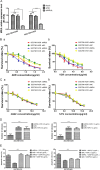Long noncoding RNA MRUL promotes ABCB1 expression in multidrug-resistant gastric cancer cell sublines
- PMID: 24958102
- PMCID: PMC4135559
- DOI: 10.1128/MCB.01580-13
Long noncoding RNA MRUL promotes ABCB1 expression in multidrug-resistant gastric cancer cell sublines
Abstract
Multidrug resistance (MDR) is the most common cause of chemotherapy failure in gastric cancer (GC) treatment; however, the underlying molecular mechanisms remain elusive. Long noncoding RNAs (lncRNAs) can be involved in carcinogenesis, but the effects of lncRNAs on MDR are poorly understood. We show here that the lncRNA MRUL (MDR-related and upregulated lncRNA), located 400 kb downstream of ABCB1 (ATP-binding cassette, subfamily B, member 1), was significantly upregulated in two multidrug-resistant GC cell sublines, SGC7901/ADR and SGC7901/VCR. Furthermore, the relative expression levels of MRUL in GC tissues were negatively correlated with in vitro growth inhibition rates of GC specimens treated with chemotherapeutic drugs and indicated a poor prognosis for GC patients. MRUL knockdown in SGC7901/ADR and SGC7901/VCR cells led to increased rates of apoptosis, increased accumulation, and reduced doxorubicin (Adriamycin [ADR]) release in the presence of ADR or vincristine. Moreover, MRUL depletion reduced ABCB1 mRNA levels in a dose- and time-dependent manner. Heterologous luciferase reporter assays demonstrated that MRUL might positively affect ABCB1 expression in an orientation- and position-independent manner. Our findings indicate that MRUL promotes ABCB1 expression and is a potential target to reverse the MDR phenotype of GC MDR cell sublines.
Copyright © 2014, American Society for Microbiology. All Rights Reserved.
Figures







Similar articles
-
AP-2α reverses vincristine-induced multidrug resistance of SGC7901 gastric cancer cells by inhibiting the Notch pathway.Apoptosis. 2017 Jul;22(7):933-941. doi: 10.1007/s10495-017-1379-x. Apoptosis. 2017. PMID: 28439677
-
DJ-1 is involved in the multidrug resistance of SGC7901 gastric cancer cells through PTEN/PI3K/Akt/Nrf2 pathway.Acta Biochim Biophys Sin (Shanghai). 2020 Dec 11;52(11):1202-1214. doi: 10.1093/abbs/gmaa110. Acta Biochim Biophys Sin (Shanghai). 2020. PMID: 33079995
-
Multidrug-Resistance Related Long Non-Coding RNA Expression Profile Analysis of Gastric Cancer.PLoS One. 2015 Aug 20;10(8):e0135461. doi: 10.1371/journal.pone.0135461. eCollection 2015. PLoS One. 2015. Retraction in: PLoS One. 2019 Dec 3;14(12):e0226210. doi: 10.1371/journal.pone.0226210. PMID: 26291830 Free PMC article. Retracted.
-
Portrayal of the complex molecular landscape of multidrug resistance in gastric cancer: Unveiling the potential targets.Exp Cell Res. 2025 Jun 1;449(1):114580. doi: 10.1016/j.yexcr.2025.114580. Epub 2025 Apr 29. Exp Cell Res. 2025. PMID: 40306607 Review.
-
The Roles of microRNAs in Multidrug-Resistance Mechanisms in Gastric Cancer.Curr Mol Med. 2020;20(9):667-674. doi: 10.2174/1566524020666200226124336. Curr Mol Med. 2020. PMID: 32209033 Review.
Cited by
-
A Review of Research Progress in Multidrug-Resistance Mechanisms in Gastric Cancer.Onco Targets Ther. 2020 Feb 28;13:1797-1807. doi: 10.2147/OTT.S239336. eCollection 2020. Onco Targets Ther. 2020. PMID: 32184615 Free PMC article. Review.
-
Focusing on long noncoding RNA dysregulation in gastric cancer.Tumour Biol. 2015 Jan;36(1):129-41. doi: 10.1007/s13277-014-2894-9. Epub 2014 Dec 13. Tumour Biol. 2015. PMID: 25501508 Review.
-
Emerging roles of non-coding RNAs in gastric cancer: Pathogenesis and clinical implications.World J Gastroenterol. 2016 Jan 21;22(3):1213-23. doi: 10.3748/wjg.v22.i3.1213. World J Gastroenterol. 2016. PMID: 26811659 Free PMC article. Review.
-
The Role of LncRNAs in Translation.Noncoding RNA. 2021 Feb 20;7(1):16. doi: 10.3390/ncrna7010016. Noncoding RNA. 2021. PMID: 33672592 Free PMC article. Review.
-
lncRNA uc009yby.1 promotes renal cell proliferation and is associated with poor survival in patients with clear cell renal cell carcinomas.Oncol Lett. 2016 Sep;12(3):1929-1934. doi: 10.3892/ol.2016.4856. Epub 2016 Jul 13. Oncol Lett. 2016. PMID: 27602119 Free PMC article.
References
-
- Kim R, Ohi Y, Inoue H, Toge T. 1999. Enhancement of chemotherapeutic agents induced-apoptosis associated with activation of c-Jun N-terminal kinase 1 and caspase 3 (CPP32) in bax-transfected gastric cancer cells. Anticancer Res. 20:439–444 - PubMed
Publication types
MeSH terms
Substances
LinkOut - more resources
Full Text Sources
Other Literature Sources
Medical
Research Materials
Miscellaneous
